The Microsoft Surface Pro (2017) Review: Evolution
by Brett Howse on June 15, 2017 9:00 AM ESTSystem Performance
The Surface Pro has always provided good performance for the size of the device, and for the new Surface Pro, we see the step to the latest 7th generation Intel Core processors. The choices are the same as the outgoing Pro 4, but one generation newer. Even though the latest Kaby Lake chips utilize the same CPU architecture as Skylake, improvements to the 14 nm process, which Intel is calling 14nm+ allows for higher frequencies, and lower power consumption, so despite having the same architecture, there are gains to be had. Let’s take a look at the CPUs.
| Surface Pro 4 CPU vs Surface Pro (2017) CPU | |||
| CPU | Core m3 | Core i5 | Core i7 |
| Surface Pro 4 | Core m3-6Y30 2 core, 4 thread 900 MHz to 2.2 GHz |
Core i5-6300U 2 core, 4 thread 2.4 GHz to 3.0 GHz |
Core i7-6660U 2 core, 4 thread 2.4 GHz to 3.4 GHz |
| Surface Pro (2017) | Core m3-7Y30 2 core, 4 thread 1.0 GHz to 2.6 GHz |
Core i5-7300U 2 core, 4 thread 2.6 GHz to 3.5 GHz |
Core i7-7660U 2 core, 4 thread 2.5 GHz to 4.0 GHz |
| Increase | 100 MHz (base) 400 MHz (turbo) | 200 MHz (base) 500 MHz (turbo) | 100 MHz (base) 600 MHz (turbo) |
You can see the base frequencies have all improved slightly, but the boost frequencies on all of the chips have increased significantly. This will allow quite a bit more responsiveness from the system, as well as overall higher performance if the device can keep the heat and power consumption in check for more sustained boosting.
Microsoft has provided the Core i7-7660U Surface Pro for review, with 16 GB of RAM and a 512 GB SSD. This adds another wrinkle over most other Ultrabooks in that it offers the Intel Iris Plus Graphics 640, compared to the HD 620 graphics in the i5 (and most other Ultrabooks) and the HD 615 graphics with the Core m3 model. The Iris Plus graphics configuration not only doubles the execution units available, from 24 to 48, but also includes 64 MB of eDRAM which can be used as a system cache as well as a graphics buffer. This provides yet another tier of memory before having to go to the (relatively) slow system memory, and depending on the application, can provide a real boost to performance.
Speaking of the integrated GPU, besides clockspeeds, this is the other area where the switch to Intel's Kaby Lake processors improves things for the Surface Pro. The GPU's media block received a significant overhaul, getting full hardware support for HEVC Main10 and the VP9 codec. The former is going to be popular with commercial streaming services over the long haul, and the latter is Google's codec of choice for YouTube, which immediately unlocks a good deal of power savings. Furthermore Kaby Lake is the first Intel processor family to get Netflix 4K support, offering a level of detail more befitting of the Surface Pro's higher resolution (though not quite 4K) display.
It's no surprise then that Microsoft has opted to keep the fan on the Core i7 model, since the extra graphics can quickly eat up the available TDP, but we did clarify with them that the Core i5 model is still running at the full 15-Watt TDP of the i5-7300U, and hasn't been intentionally set to a lower TDP via cTDP functionality. Hopefully we’ll have a chance to test that at a later date and see how the lack of active cooling impacts it.
Speaking of cooling, the Surface Pro now includes a slider if you click on the battery icon, which allows you to quickly and easily change the power mode. The choices are Best Battery Life, Better Performance, and Best Performance, with Best Battery Life as the default and recommended. Modern Standby devices have not allowed you to adjust the power settings very much before, so it’s nice to see some choices here now. Microsoft let us know that the slider settings adjust CPU efficiency and the PL1 / PL2 settings. In “battery saver” the CPU and GPU are throttled with priority given to the GPU. In “best performance” the CPU and GPU run at full power. This makes a big difference on noise levels, but also impacts performance, and we’ll dig into that when we look at the cooling later on. For the following scores, Best Performance was chosen for all of the graphs.
We’ve tested the Surface Pro with our standard laptop test suite, and comparisons will be among other similar devices. The Surface Pro 4 in the graph was the Core i5-6300U model, and since we didn’t get to test anything with Core i7-6660U, the Surface Book will be used as a comparison with the Core i7-6600U (although it did have external graphics as well). For other comparisons, there are some more Ultrabooks, and the Dell XPS 15 with quad-core 45-Watt Skylake to give a comparison against a larger device.
PCMark
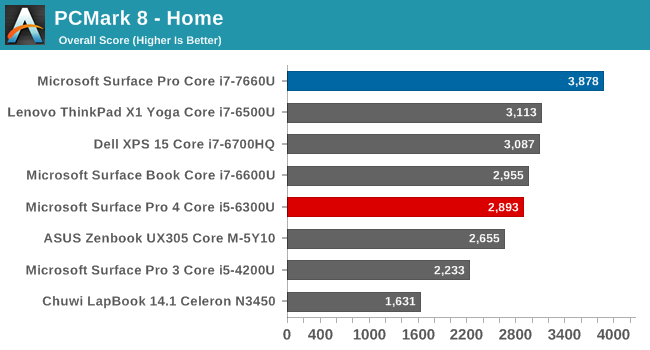
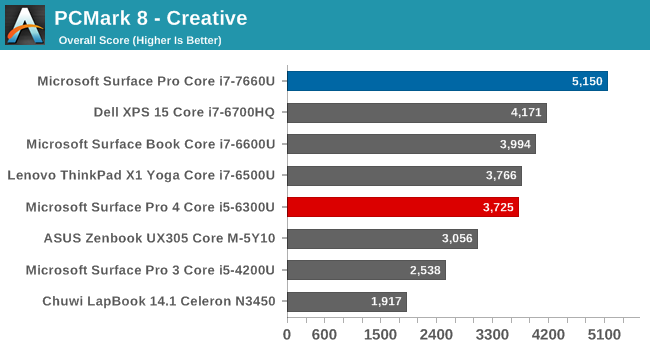
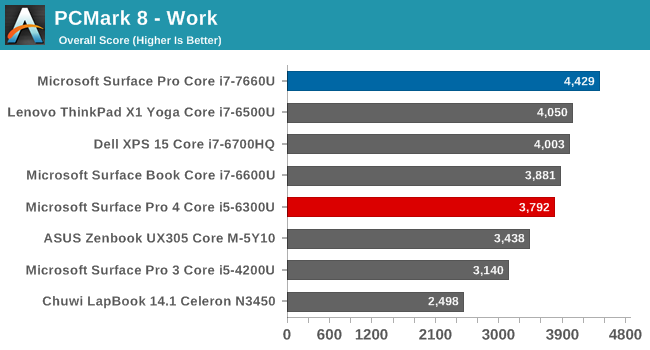
PCMark has just launched an updated version of their all-in-one PC test, and once we have some more data from it, you should start to see it appear in our reviews. For now, since we have a lot of existing data on PCMark 8, we’ll showcase that. PCMark really tries to be a real-world test, with many different workloads that range from short, bursty tests, to longer sustained 3D gaming. As you can see, the Surface Pro is a significant step ahead of every other system here, with the combination of a higher frequency CPU, 64 MB of eDRAM, and double the execution units in the GPU of most other devices. Both Home and Creative see the largest gains, since they both have some gaming involved, but even the Work scores are a good step above the rest of the devices, including the quad-core Dell XPS 15.
Cinebench
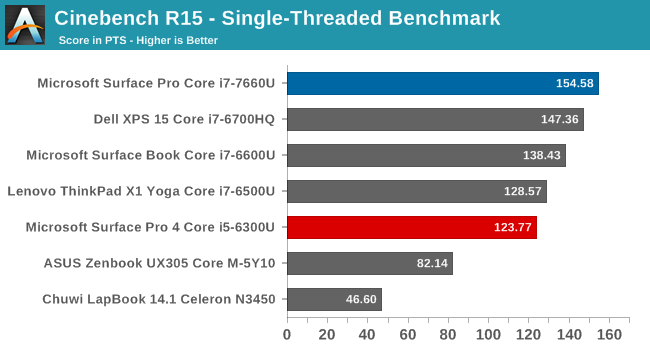
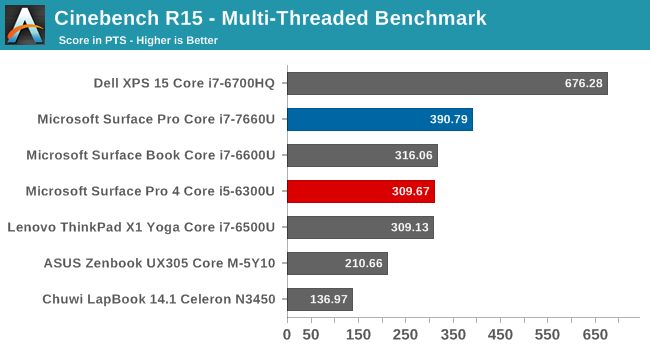
Cinebench is a rendering test, and we showcase the CPU scores only. It allows both single-threaded and multi-threaded versions of the test, and since it’s mostly CPU based, it’s a great display of the progress in CPU performance gains. You can see that the 15 W Core i7-7660U in the Surface Pro easily beats everything in the single-threaded version of this test, but the quad-core Dell XPS 15 unsurprisingly dominates on multi-threaded testing.
x264


Much like Cinebench, x264 is mostly a CPU test, and a video clip is converted on the CPU into h264. There is no single-threaded option though, so you can see the quad-core parts still offer a lot more grunt for these kinds of tasks, but compared to the other Ultrabooks, the Surface Pro is the fastest again.
Web Tests
Browsing performance is tough to capture well, mostly because the results are so heavily impacted by the browser. Browsers continue to improve on scripting performance, so over time, even the same system will improve somewhat. Still, it’s important to look at since so much of our time is spent on the web. Google Octane is now deprecated, and we’ll phase it out soon, but since we have a large sample of older devices tested, it’s still a good test to check out.
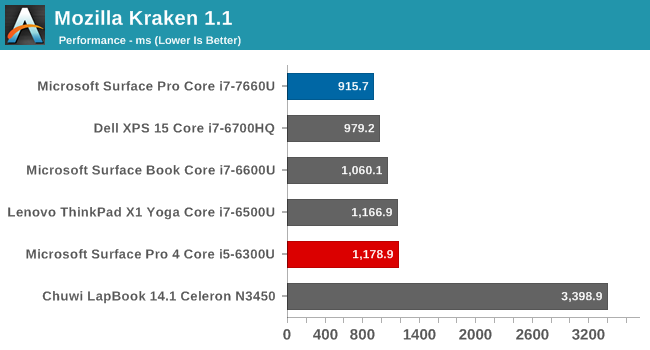

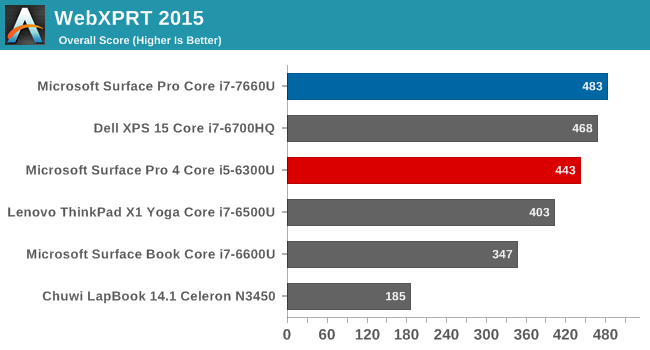
The combination of the latest Edge browser in the Creators Update version of Windows 10, with the speedy Core i7-7660U, put the Surface Pro pretty much at the top of all of these results.
System Performance Conclusion
The amount of performance that’s able to be packed inside of such a small device continues to impress, and for the first time, we’ve been able to check out the Core i7 model with Intel Iris graphics. Surface Pro can easily hold its own against any other Ultrabook, and often surpass it in performance. It would be great to see more vendors offering Intel's Iris graphics, since there are only a handful at the moment. But regardless, the move from Skylake to Kaby Lake has been a nice step forward, despite the CPU architecture remaining the same.











124 Comments
View All Comments
fpsvash - Thursday, June 15, 2017 - link
Great write-up, Brett. I really hope AT is able to get a Core i5 model in to evaluate its thermals.id4andrei - Thursday, June 15, 2017 - link
Yes, that's the sweet spot model. So far all the sites I've read seem to have received the i7 for reviewing purposes. The 15 should have better battery life. I recall once upon a time AT reviewed the i7 MBA and although it performed better than the i5, it payed a battery penalty.KaarlisK - Thursday, June 15, 2017 - link
Where is my i3 with 8GB of RAM? Hrrrrr....thesavvymage - Thursday, June 15, 2017 - link
yup. $1000 for a core m3 with 8gb ram and 256gb ssd wouldve been perfectkenansadhu - Friday, June 16, 2017 - link
If the keyboard is included in the $1000 priceAllIDoIsWin - Friday, June 16, 2017 - link
And maybe an external battery pack.. but $1000, seriously?!damianrobertjones - Monday, August 21, 2017 - link
There's a super amazing option that comes with the Surface price tag... "Don't buy it".NonSequitor - Thursday, June 15, 2017 - link
First page typo: the Surface Pro 4 was not released this summer.gsalkin - Thursday, June 15, 2017 - link
Awesome job. Please do this for the Macbook Pros?AllIDoIsWin - Friday, June 16, 2017 - link
They're rubbish, done ;)